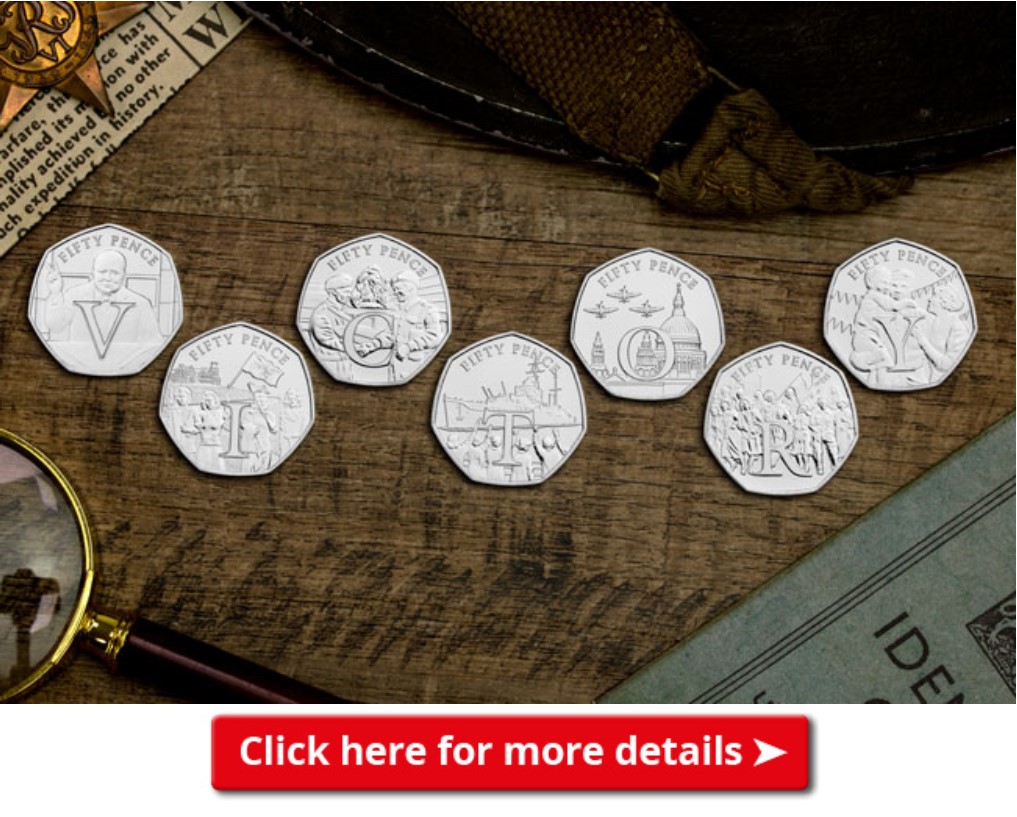Posts Tagged ‘Coin Collecting’
V for VICTORY! Brand new 50p coins issued by the Isle of Man to mark 75 years since VE Day
The 8th of May 2020 marks the 75th Anniversary of VE Day – the day which signified the end of World War II and brought long awaited peace to our nation, as Victory in Europe was declared.
The many years of destruction and lives lost finally came to an end on that momentous day, and millions from around the world took to the streets to celebrate.
This year, celebrations will reignite for the peace so bravely won, as events planned up and down the UK will commemorate 75 years since the guns fell silent.
And to mark such an historic anniversary, a brand new set of seven 50p coins has been authorised for release on the Isle of Man by Her Majesty the Queen.
This remarkable new Victory 50p Set pays tribute to our nation’s soldiers, sailors and airmen as they began their journey home 75 years ago following the Allied victory which swept across Europe.

Issued by the Isle of Man, each coin depicts a design and letter reflecting victory during this time, including:
V
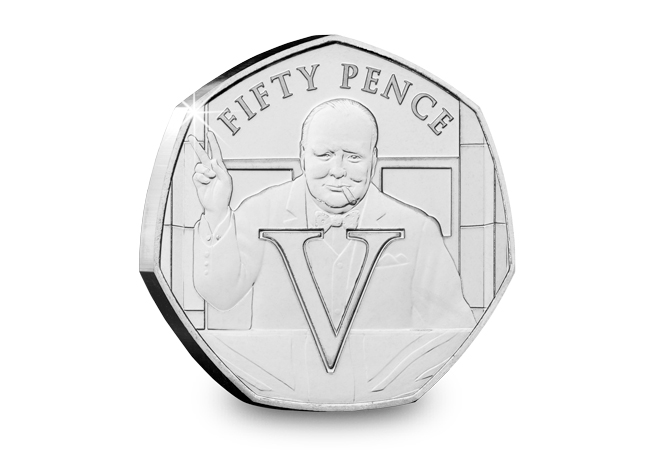
The first coin features the letter V and depicts Churchill with his famous V for Victory stance. Excitingly, this is the first time Churchill has appeared on a 50p coin, although he has been honoured on no less then three UK crown coins.
I
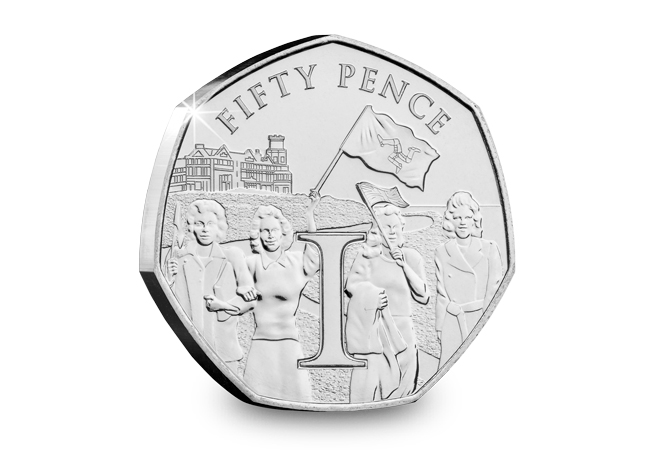
The next coin features the letter I and shows citizens of the Isle of Man celebrating the end of WWII.
C
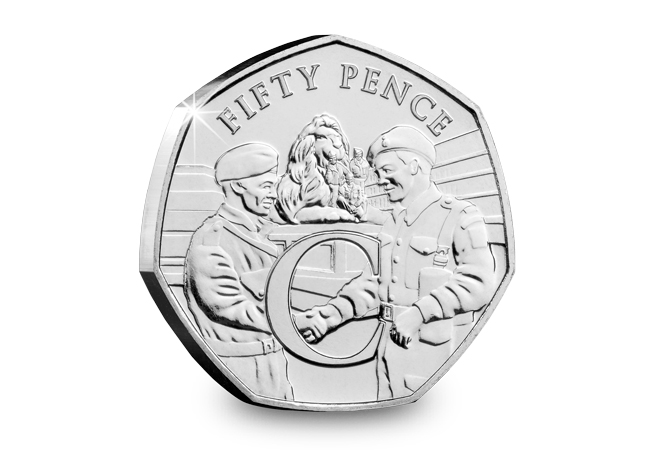
The letter C features on the third coin, which shows soldiers shaking hands in front of Trafalgar Square.
T

The next coin features the letter T and shows the HMS Dido Battleship returning home after the war.
O
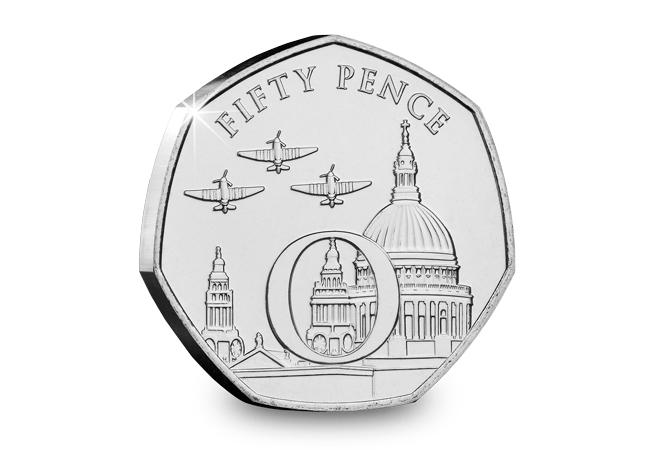
This coin features the letter O and depicts Spitfires flying over St. Paul’s Cathedral in London.
R
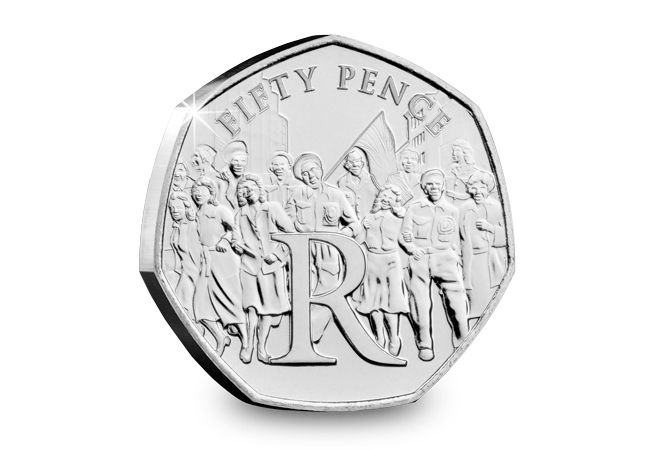
The next coin features the letter R and represents the street party celebrations that took place when it was announced the war was over.
Y
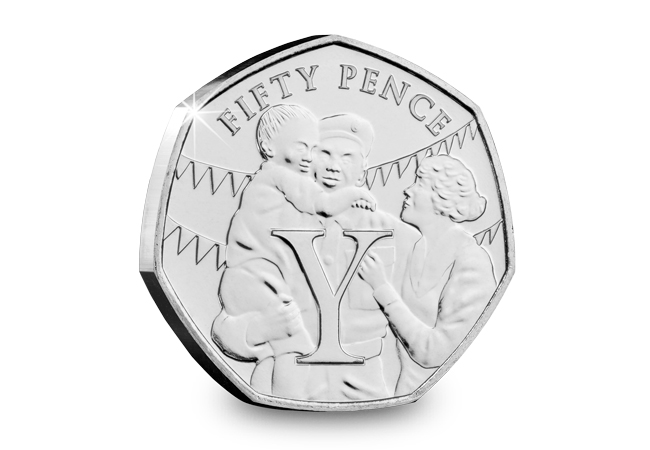
The final coin features the letter Y and depicts a moving scene showing a soldier returning home to his family.
Can I find these coins in my change?
Isle of Man 50ps are famously popular with collectors, especially as their mintage figures are so low, and these coins are no exception.
Initially 25,000 of each 50p will be entering circulation on the Isle of Man, so any British Isles collectors out there should keep their eyes out for these wonderful new coins.
Of course, British Isles coins do turn up in our UK change from time to time, despite the fact they are not legal tender in the UK, however I’m sure these coins will be quickly snapped up by Isle of Man collectors and so you’d have to be very lucky to come across one.
The best ways to own the Victory 50p Set
There are a number of ways to own the Victory 50p Set, which has been issued in Brilliant Uncirculated and Silver Proof quality.
The Brilliant Uncirculated coins are presented in a VE Day 75th Anniversary presentation pack – a must have for collectors of military commemoratives.
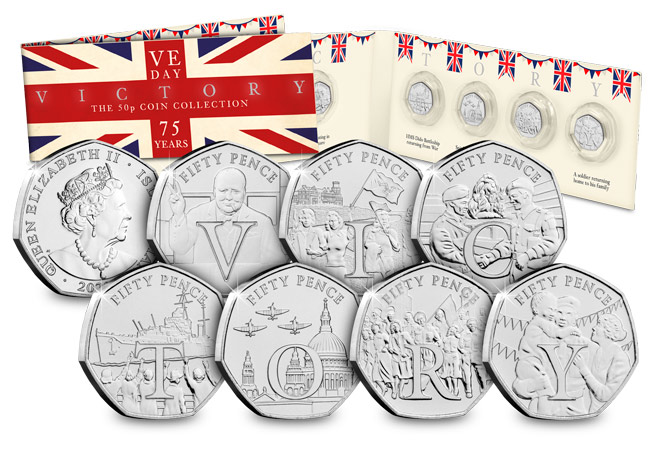
Just 2,020 Silver Proof Victory 50p Sets have been struck worldwide. The coins are struck to a Proof finish from .925 Silver with selective Gold Plating on each of the letters and come displayed in a luxury wooden case.
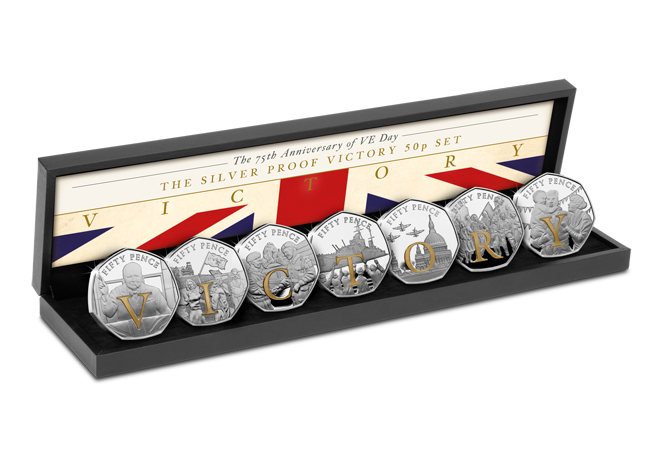
What’s more, this is the only way you can own all seven of these poignant 50p coins in collector quality. Only the Churchill ‘V’ for Victory coin will be released individually.
Churchill V for Victory 50p coin
You can also secure the Churchill V for Victory 50p coin individually in Brilliant Uncirculated, Silver Proof or Gold Proof quality.

With just 5,000 Churchill V for Victory Silver Proof 50p coins and only 250 of the Gold Proof coins, the strict edition limits really add to the collectability of these coins.
These 50ps really are a timeless tribute to the thousands of allied troops who fought tirelessly and sacrificed their lives to bring long awaited peace to our nation, and in this important anniversary year, they make for an incredibly poignant issue to commemorate 75 years since VE Day.
Secure your Victory 50p coins
Click here to find out more about the Victory 50p coins and add them to your collection >>
2020 Scarcity Index Update!
We’re excited to reveal to you the very first Scarcity Index of 2020!
The updated 50p, A-Z 10p and £2 indexes below allow you to discover how sought-after the coins in your collection really are…
This information has been compiled using data from the Change Checker Swap Centre and presented in the easy to use indexes below, with arrows to signify how many places up or down a coin has moved since the last Scarcity Index.
50p Scarcity Index
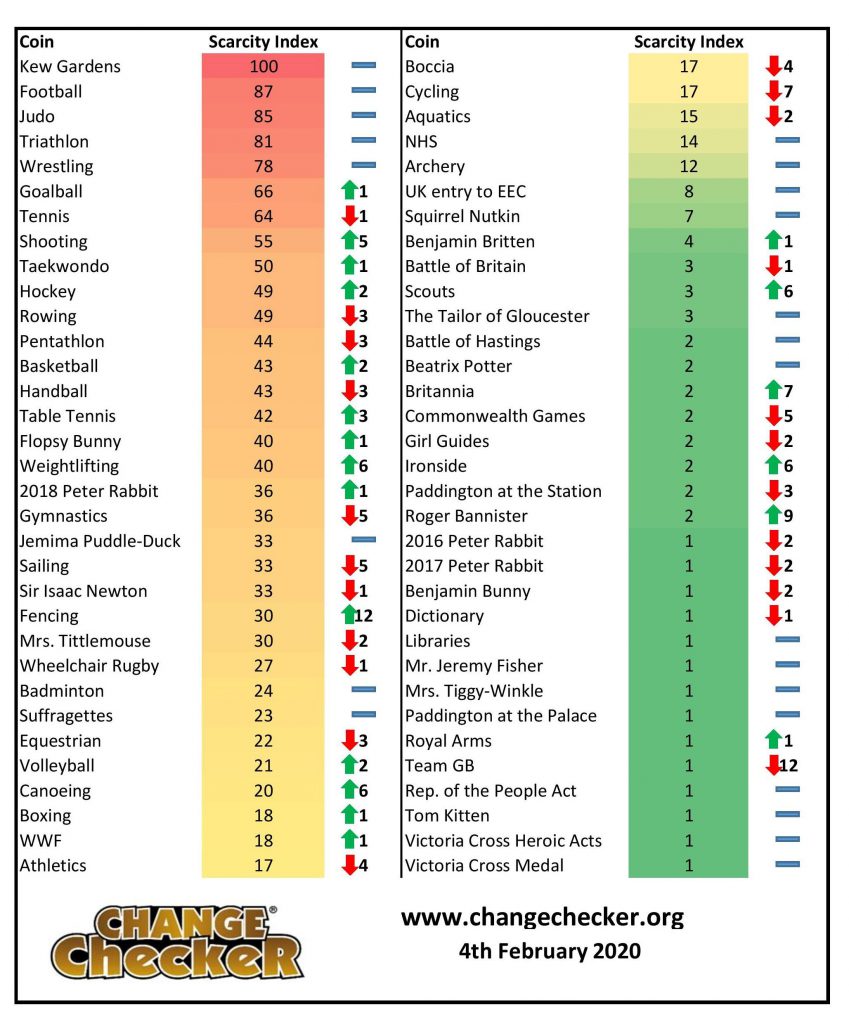
The previous Scarcity Index update saw some exciting changes to the 50p index, as we were able to include the 2018 50p coins following the release of their mintage figures.
This was great news for Change Checkers who have the 2018 Beatrix Potter 50ps in their collection, as both the Flopsy Bunny and Peter Rabbit 50ps have proved incredibly sought-after.
Despite both coins having the same mintage figure of 1,400,000, the Flopsy Bunny 50p is the most sought-after of the Beatrix Potter coins and is in fact the scarcest non-Olympic 50p coin in circulation, aside from of course the Kew Gardens 50p – the UK’s most sought-after circulation 50p.
Whilst both the Flopsy Bunny and 2018 Peter Rabbit 50ps have moved up the index one place since the last update, the other 2018 50ps haven’t fared quite so well, with the Mrs Tittlemouse and Paddington at the Station both moving down the index and the other 2018 50ps remaining unchanged.
The biggest mover on this latest Scarcity Index update goes to the Olympic Fencing 50p, which has moved up the index an incredible twelve places, following its five place drop on the previous update.
As we look forward to the Olympic Games which will be held in Tokyo later this year, perhaps we’ll see more of the Olympic 50ps increase in popularity by the next Scarcity Index update.
A-Z 10p Scarcity Index
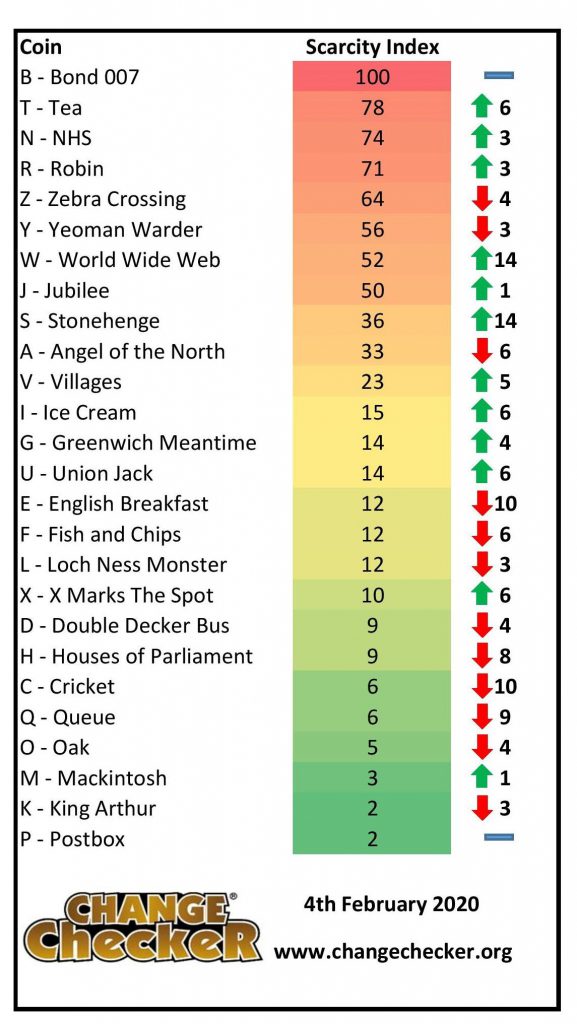
We’re used to seeing quite a bit of movement on the A-Z 10p index as these particularly tricky-to-find coins are snapped up by collectors.
Interestingly, in this latest update only the top and bottom coins have remained unchanged, with B for Bond staying on top spot as the current scarcest A-Z 10p coin in circulation.
For many, this coin seems to be a firm favourite from the A-Z of Great Britain collection which was released in 2018, so it comes as no surprise that it has found its way to the top of the list.
P for Postbox is unfortunately bottom of the pile once again, although it’s worth remembering that all of these coins are considered sought-after and collectors fortunate enough to come across just one will be considering themselves lucky.
The biggest movers on the latest 10p index update are W for World Wide Web and S for Stonehenge, which have both moved up the index by 14 places.
S for Stonehenge actually dropped by 14 places in the previous index, so this could be the coin levelling back out again.
It will be interesting to see how the index changes as more collectors come across these coins and as we await the release of the 2019 mintage figures. We currently know that 220,000 of each design entered circulation in 2018 and a further 2.1 million coins overall were released in 2019, but exact figures for individual 2019 designs are currently unknown.
£2 Scarcity Index
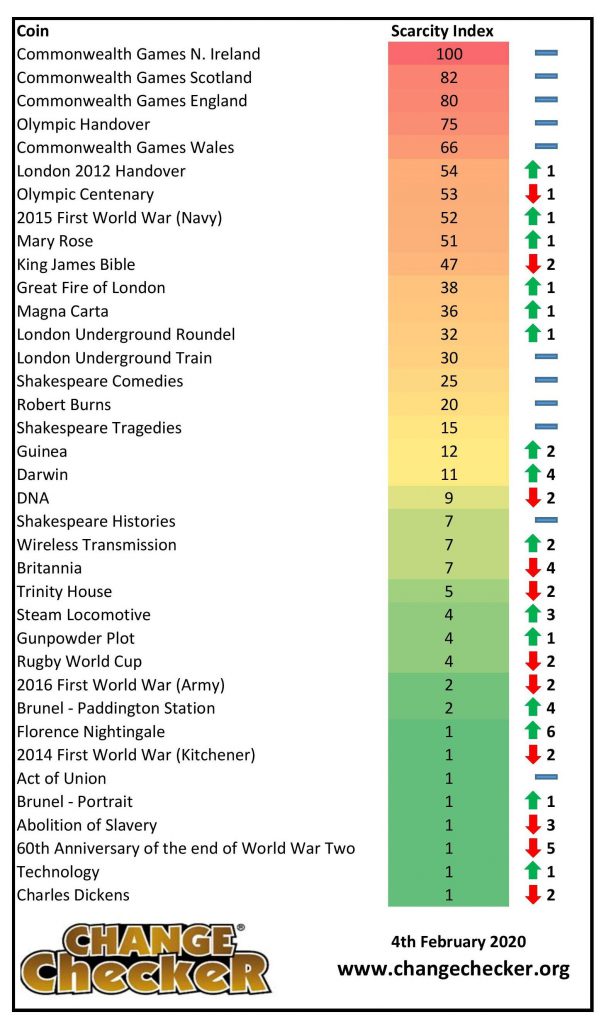
Following the 2018 mintage figure reveal, we know that no £2 coins have entered circulation since 2016, so the £2 index continues to remain fairly stable with no new coins to add to the mix.
The top five coins are unchanged since the last index and it comes as no surprise that the Commonwealth Games Northern Ireland £2 remains on the top spot, as this £2 has a mintage figure of just 485,500 and is considered incredibly sought-after amongst collectors.
All three Olympic themed £2 coins (Olympic Handover, Olympic Centenary and London 2012 Handover) also remain very close to the top of the index and I wonder if the Tokyo Olympics this year will affect the scarcity of these already very popular coins.
The biggest mover on the £2 index is the Florence Nightingale coin, which has moved up by six places, whilst the 60th Anniversary of World War Two coin has moved down by five places to the third from bottom space.
As I’m sure you’ll agree, it would be fantastic to see some new £2 coins entering circulation and how they might affect the £2 Scarcity Index. Fingers crossed they’ll be enough demand for these coins to enter circulation soon!
How your Scarcity Index works
Generally collectors have had to rely upon mintage figures to identify the scarcest coins. But they only tell part of the story. Trying to find a good quality coin from 15 – 20 years ago, even for a higher mintage issue, is much more challenging than a more recent issue, as coins become damaged over time and are ultimately removed from circulation.
Additionally, some designs are more hoarded than others by people who might not normally collect coins – the poignant First World War £2 Coin series being an example. Finally, it can be up to a couple of years before the Royal Mint eventually confirms the actual mintage for an issue.
That’s why we have combined the mintage information with two other key pieces of information.
- How many of each design are listed as “collected” by Change Checkers, indicating the relative ease of finding a particular coin.
- The number of times a design has been requested as a swap over the previous 3 months, showing the current level of collector demand.
Importantly, as new coins are released and popularity rises and falls across different designs the Scarcity Index will be updated quarterly allowing Change Checkers to track the relative performance of the UK’s circulation coins.
How much are my coins worth?
The Scarcity Index does not necessarily equate to value but it is certainly an effective indicator. For example, the Kew Gardens 50p coin commands a premium of up to 200 times face value on eBay.
You can use the 6 point guide to help you determine a more realistic value for your coins.
What about £1 Coins?
The £1 Scarcity Index has already been published for the Round £1 coins and, because they are no longer being issued, this is now set in stone.
If you’re interested in coin collecting, our Change Checker web app is completely free to use and allows users to:
– Find and identify the coins in their pocket
– Collect and track the coins they have
– Swap their spare coins with other Change Checkers

Sign up today at: www.changechecker.org/app
The history of the ‘Ten Bob’ note – a world before the 50p coin…
Back in the 1960’s the 10 Shilling Note, or ‘ten bob’ as it was commonly known, would go pretty far – buying you 6 pints of beer, 10 loaves of bread, or 17 pints of milk.
Nowadays it’s hard to imagine the decimal equivalent, the 50p, buying so much. In fact, 50p can only just buy you one pint of milk today! And you can certainly forget that pint of beer!
But before the much loved 50p came along, the old 10 Shilling banknote had a fascinating history.
From being issued by the Government in a wartime emergency, changing colour to avoid forgery from the Nazis and eventually being replaced by the world’s most popular coin, it’s important that the history of the ten bob isn’t forgotten.
The Emergency Banknote
In August 1914, the British economy was in turmoil due to the instability caused by the oncoming war on the continent.
Bankers and politicians were desperately looking for ways to secure Britain’s finances and prevent the banks from collapsing.
The Government decided that a large supply of banknotes should be made available for the value of 10 Shillings, making it easy for the public to make small transactions.
However, The Bank of England was not able to prepare and print the required number of notes quickly enough, so the Government took the unprecedented step of deciding to issue the notes itself.

These banknotes became known as the Treasury banknotes and were unlike anything the British public had ever seen.
Until this point the lowest denomination banknote was £5, and in those days this was such a large sum that many people would never have seen or used a banknote before.
By issuing a 10 Shilling banknote, the Treasury created the first widely circulated banknotes in England.
The Wartime colour change
In 1928, the responsibility for printing 10 Shilling notes was transferred to the Bank of England.
However, not long afterwards, Britain once again found itself at war and again found its currency under threat.
During World War II, Nazi Germany hatched a plan to undermine British currency.
Through ‘Operation Bernhard’ they believed they had discovered a method to manufacture counterfeit ‘White Fivers’, and planned to distribute these in huge numbers to destabilise the British currency.
The Bank of England decided to take preventative action and, as a result, the 10 Shilling note was changed for the duration of the war to a distinctive pink and blue colour in an attempt to prevent counterfeiting.

It was also revolutionary in the progression of banknote technology by incorporating a metal security thread.
The Nazis couldn’t compete with this high level anti-forgery technology and hence the British 10 Shilling note held strong and supported the British wartime economy, as it had done since its conception.
The 50p revolution
After undergoing a colour change during the Second World War, the ten bob note reverted to its familiar red-brown until 1961, when a new design featuring a portrait of Queen Elizabeth II was introduced.
Despite a new design for the 10 Shilling note featuring Sir Walter Raleigh on the reverse being approved in 1964, as part of the process of decimalisation it was dropped in favour of the new fifty pence coin introduced in 1969.

The principle reason for the change was to save the Treasury money.
The notes had an average lifetime of around five months, whereas a coin could last for fifty years.
The 50p has since gone on to become the world’s most popular and collected coin, but nowadays few realise the fascinating history of its predecessor, the 10 Shilling banknote!
Do you remember the ten bob note? Let us know in the comments below!
If you’re interested in coin collecting, our Change Checker web app is completely free to use and allows users to:
– Find and identify the coins in their pocket
– Collect and track the coins they have
– Swap their spare coins with other Change Checkers

Sign up today at: www.changechecker.org/app


